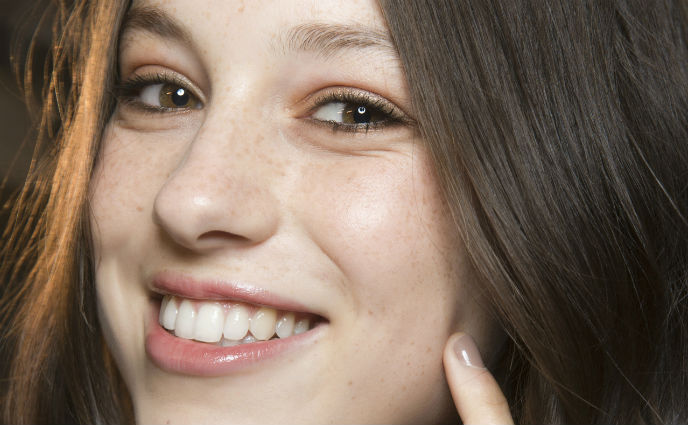What people think it is: Milia are known as "baby acne" and are commonly found on infants. Except, I just found one under my eye. The skin of a newborn baby sounds like something I'd pay a lot of money for, but not if it includes acne.
What it actually is: Milia are tiny epidermal cysts that look like whiteheads, but they are not "poppable." Milia form when keratin, the protein that makes up your hair and nails, becomes trapped under the first layer of skin at the base of a hair follicle or sweat gland. On adults, they pop up around the eyes and nose.
How you get it: Sun exposure and damage to the skin (such as lasers, microdermabrasion, long-term use of steroid creams, or other injury to the skin) encourage their formation. Heavy lotions can also increase their likelihood, since they discourage the skin from sloughing off naturally. And I thought that oily eye cream was supposed to be doing wonders for my skin!
How you get rid of it: Dr. Krant says they require tiny surgical removals if they don't go away on their own. She warns that they should not be removed by an aesthetician. Cost for removal will vary by dermatologist, but usually it's under $100 to have several removed. After noticing the milia under my eye, I swore off heavy eye creams (which tend to clog the pores and encourage milia) and started using an AHA cleanser (I like Mychelle Dermaceuticals Pure Harmony Cleanser) because the formula exfoliates without using harsh beads that might cause more trauma to the area. The little bump prevailed for about seven months before falling off while I was applying my under eye concealer one morning. Milia success story!
How you prevent it: "The best way to prevent them is to review your skin care routine to make sure there are no irritating components or rough physical parts to it, since skin needs to be treated gently to prevent microscopic inflammation and its consequences," says Dr. Krant. While exfoliating is important for the prevention of milia, make sure the product you're using doesn't contain large, harsh beads, like walnut shells. Rough beads will make microscopic tears in the skin, encouraging milia formation.
What it actually is: Milia are tiny epidermal cysts that look like whiteheads, but they are not "poppable." Milia form when keratin, the protein that makes up your hair and nails, becomes trapped under the first layer of skin at the base of a hair follicle or sweat gland. On adults, they pop up around the eyes and nose.
How you get it: Sun exposure and damage to the skin (such as lasers, microdermabrasion, long-term use of steroid creams, or other injury to the skin) encourage their formation. Heavy lotions can also increase their likelihood, since they discourage the skin from sloughing off naturally. And I thought that oily eye cream was supposed to be doing wonders for my skin!
How you get rid of it: Dr. Krant says they require tiny surgical removals if they don't go away on their own. She warns that they should not be removed by an aesthetician. Cost for removal will vary by dermatologist, but usually it's under $100 to have several removed. After noticing the milia under my eye, I swore off heavy eye creams (which tend to clog the pores and encourage milia) and started using an AHA cleanser (I like Mychelle Dermaceuticals Pure Harmony Cleanser) because the formula exfoliates without using harsh beads that might cause more trauma to the area. The little bump prevailed for about seven months before falling off while I was applying my under eye concealer one morning. Milia success story!
How you prevent it: "The best way to prevent them is to review your skin care routine to make sure there are no irritating components or rough physical parts to it, since skin needs to be treated gently to prevent microscopic inflammation and its consequences," says Dr. Krant. While exfoliating is important for the prevention of milia, make sure the product you're using doesn't contain large, harsh beads, like walnut shells. Rough beads will make microscopic tears in the skin, encouraging milia formation.
What people think it is: Acne on the back of your arms? A mosquito attack? A skin graft from a chicken?
What it actually is: Keratosis Pilaris (KP) is a usually painless (but annoying) skin condition that can range from a few rough patches on the back of your upper arms to rough, red, irritated skin on your arms, thighs, back and face. It's caused by a build up in keratin (similar to milia development).
How you get it: Doctors don't know the specific cause of KP, but find that it runs in families.
How you get rid of it: Moisturizers with lactic acid or urea (try Eucerin Intensive Repair Very Dry Skin Lotion) can help eliminate KP. If that doesn't work, Dr. Krant suggests seeing your dermatologist for a prescription cream. "Also worth checking, though their relationship is currently at rumor level only, is whether you have gluten sensitivity, low vitamin D, or not enough beta carotene in your diet," she adds.
How you prevent it: There's no way to avoid KP, since it's not a disease that's "caught," but rather a genetic predisposition. Keeping your showers short and lukewarm and existing over-exfoliation will help discourage KP, since those practices just irritate hair folicles.
What it actually is: Keratosis Pilaris (KP) is a usually painless (but annoying) skin condition that can range from a few rough patches on the back of your upper arms to rough, red, irritated skin on your arms, thighs, back and face. It's caused by a build up in keratin (similar to milia development).
How you get it: Doctors don't know the specific cause of KP, but find that it runs in families.
How you get rid of it: Moisturizers with lactic acid or urea (try Eucerin Intensive Repair Very Dry Skin Lotion) can help eliminate KP. If that doesn't work, Dr. Krant suggests seeing your dermatologist for a prescription cream. "Also worth checking, though their relationship is currently at rumor level only, is whether you have gluten sensitivity, low vitamin D, or not enough beta carotene in your diet," she adds.
How you prevent it: There's no way to avoid KP, since it's not a disease that's "caught," but rather a genetic predisposition. Keeping your showers short and lukewarm and existing over-exfoliation will help discourage KP, since those practices just irritate hair folicles.




